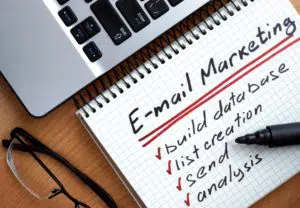What is Ecommerce Marketing? Surefire Roadmap for Business Growth Acceleration
Both foreseeable and unpredictable occurrences have pushed businesses worldwide to rethink, refine, or entirely overhaul their customer outreach strategies.
For instance, the global digitization of businesses and the numbing effects of the Covid-19 pandemic have nudged entrepreneurs worldwide toward electronic media marketing.
Moreover, the constantly evolving business terrain is becoming increasingly competitive, forcing business owners to dedicate more resources to marketing.
And that’s not all.
The bulk of retail customers are opting to purchase products and services online. Thus, businesses are finding it increasingly unfavorable, even impossible, to promote their brands, offer services, and satisfy their customer bases without investing in eCommerce marketing.
Surprising, this is one of the main reasons a decent number of enterprises don’t smash their revenue generation targets.
You may be wondering whether eCommerce marketing is worth the hype.
Consider this: By 2023, eCommerce revenue in the US alone is set to rise to a whopping $4.9 trillion. That’s why global entrepreneurship is currently on an all-out online shift. However, with most marketing outreach campaigns taking place online, it’s challenging, even overwhelming, for businesses to identify the best way to ride the current.
Choosing, building, and launching a suitable eCommerce platform are daunting tasks to many business owners.
Worse yet, the platform must be responsive, user-friendly, and feature-rich to amplify prospect traffic, attract more leads, and successfully nudge them through the lead generation funnel to loyal customers.
What’s more, choosing the best marketing tactics can be challenging even with a basic customer outreach strategy. Nevertheless, this guide will introduce you to eCommerce marketing concepts and tools and show you the best strategies to kick-start a successful eCommerce enterprise.
We’ll also reveal a proven eCommerce marketing blueprint along with expert tips to scale your current eCommerce venture to attract more prospects, drive more sales, and keep customers satisfied and loyal.
But first:
What is Ecommerce?

Ecommerce is a collective term that sums up the process of transacting business online. While it commonly refers to purchasing and selling services and products over the internet, it also encompasses online data and monetary transfer.
For instance, online stores, subscription-based enterprises, web-based marketplaces, online auctions, and crowdfunding programs all entail eCommerce.
Types of eCommerce Models
Often, online buyers and sellers interact through these four main e-commerce business models:
-
- Business to Business (B2B) eCommerce: In this model, a business organization offers its products or services to another business. Perfect examples include online wholesale (bulk) sellers and SaaS (software as a service) enterprises.
- Business to Consumer (B2C) eCommerce: Businesses in the B2C eCommerce model sell directly to the end-users. They include online retail businesses.
- Consumer to Business (C2B) eCommerce: In a C2B e-commerce model, a consumer offers business value to an eCommerce enterprise. A good example is a freelance online worker using an online portal for business transactions.
- Consumer to Consumer (C2C) eCommerce: C2C e-commerce takes place between two or more customers, such as a consumer selling pre-owned products or services to other end users online.
What is an eCommerce Platform?

Ecommerce platforms refer to cloud-based or on-premise enterprise software applications that provide a suitable environment for businesses to establish and manage online trade.
A fitting eCommerce platform includes all requisite features and tools for a business to market and offer its products and services, define pricing, run marketing campaigns, monitor performance, and control inventory.
A cloud-based e-commerce platform is ideal for most SMEs due to its almost negligible upfront setup budget. Better still, it offers you the freedom and convenience to upscale or downscale your business without making major changes to your business model.
Either way, all eCommerce platforms need a seamless and effective eCommerce marketing strategy to promote the business brand, funnel in leads, drive sales, and keep customers happy.
Now let’s dive in:
What is eCommerce Marketing?

Ecommerce marketing is the process of generating prospects for an eCommerce enterprise, driving them through the sales funnel, and ultimately converting them to sales and repeat customers. It entails all marketing efforts geared toward driving traffic to your online business for new customer acquisition and post-purchase customer loyalty.
Essentially, a holistic eCommerce marketing blueprint encompasses marketing approaches both on and off your business website.
And there’s more:
You can leverage eCommerce marketing to drive more sales by targeting specific products and services or the entire business. Whichever approach you adopt, it’s crucial to customize your eCommerce marketing campaigns to serve your brand performance end make it user-friendly.
You’ll agree with financial experts worth their salt that there’s no one-size-fits-all eCommerce marketing plan for all businesses. Marketplace dynamics and marketing tactics are always changing.
Similarly, you should advance your marketing policy in tandem with these changes to optimize both organic and targeted traffic for the best ROI.
Is eCommerce marketing really important or simply an oversold fad? Read on to find out its proven perks, along with everything you need to know to run successful eCommerce marketing campaigns.
Benefits of eCommerce Marketing
Some of the most obvious advantages of a successful eCommerce marketing strategy include:
- It makes your business known to target prospects via brand awareness and promotion.
- Drives lead traffic to your business website and through the conversion and sales funnels
- It transitions your business website visitors to new customers and promotes brand loyalty among the existing customer base.
- It helps people search for the products or services you offer to find your business more easily.
- Enhances business growth by nudging customers to shop more frequently and make larger orders
- Enhances customers’ post-purchase experiences to enhance customer loyalty and satisfaction
- Enlivens existing customers with new experiences, timely offers, and appropriate offers
- Leads to a highly responsive eCommerce user interface and improved user experience
- It generates instant and timely customer feedback for business products and services, thus helping you monitor and customize various marketing processes for optimal business performance.
Remember, you want your business to be easily visible to new prospects and repeat customers alike. Thus, launching an eCommerce marketing plan isn’t enough.
Above this, you must keep your target customer base up-to-date on your business offers to stay market-viable. This way, you’ll have a steady flow of prospect leads and customer traffic through the conversion and sales funnels, respectively.
Common eCommerce Marketing Terminology

Here are the meanings of some important terms used in eCommerce marketing:
- Persona
Persona refers to a specific set of people who exhibit the same behaviors in their purchasing process. Factors used to identify specific personas include age, financial muscle, gender, profession, leisure activities, and purchasing intent.
Personas are vital in helping you identify different buyers and learn what motivates them to make a purchase. Consequently, you can tailor your eCommerce marketing tactics to target specific market segments.
- Brand
A brand is generally the face of your business and constitutes the image that prospects and customers have of your enterprise. Ecommerce business branding encompasses your business logo, website colors, and tagline, among others. Business owners should be keen on their branding, considering the punch it packs in eCommerce marketing.
Business branding creates the first impression of your business on prospects. It forms a mental image associated with your enterprise and points customers to the type of products or services your eCommerce business offers.
- KPI
Enterprises exploit KPI (Key Performance Indicators) as milestones to evaluate the performance of their eCommerce marketing strategies against a set goal.
Key performance indicators for eCommerce marketing differ in various business models. Still, they are all vital in monitoring the progress of your marketing campaigns, identifying weak links, and setting future business objectives.
- ROI (Return on Investment)
Used to measure the returns and efficacy of investment in eCommerce marketing, ROI shows which strategy is working and which one is failing. It compares your funnel after using a specific marketing strategy to your returns without using the said strategy.
Essentially, a positive ROI shows that the marketing strategy you’re investigating is effective, while a negative one should be an alarm to revise the policy.
- ROAS
Similar to ROI, Return on Ads Spend (ROAS) measures the return on your eCommerce marketing investment. However, ROAS is used with paid ads.
Here, you must factor in all ad costs to identify which has the best positive returns.
Similar Article – Ecommerce SEO: How to Get Targeted Traffic (Customers) From Google Searches
Types of eCommerce Marketing Campaigns
Popular eCommerce marketing channels today include:
-
Search Engine Marketing (eCommerce SEO and PPC)

Search engine marketing (SEM) encompasses both Search Engine Optimization and paid advertising (pay-per-click marketing) on search engines.
SEO is a free way of optimizing eCommerce marketing content for easier and faster visibility to prospects and customers. It leverages organic traffic and involves learning search engine ranking algorithms and observing on-site and on-page best practices to make your business rank higher on search engine result pages (SERPs).
On the other hand, pay-per-click (PPC) eCommerce marketing is a premium audience-targeting marketing service. It entails paying search engines to slot your business at the top of search results. Essentially, you pay a pre-agreed amount for each click on your business ad campaigns.
In turn, PPC marketing campaigns put your business right in front of your target customer base, often resulting in higher subscriptions and purchases compared to other eCommerce marketing strategies. However, although PPC marketing presents faster results on ROAS, it’s unsuitable for SMBs with tight eCommerce marketing budgets.
- Here are a few proven hacks to design a sound SEO eCommerce marketing strategy for higher organic ranking on search engines:
- Optimize your eCommerce business website for mobile access
- Research, identify, and use viable keywords and keyword phrases to rank your business higher in SERPs
- Perform expert on-page and on-site SEO audits and fix the errors like duplicate pages and broken links
- Enhance local SEO via a Google My Page profile for your business
Ultimately, a solid search engine eCommerce marketing drive exposes your business to more prospects, thus helping you to generate more leads quickly.
-
Ecommerce Email Marketing

Some eCommerce businesses overlook email marketing and write it off as an outdated marketing approach. Nevertheless, the strategy is still effective today. Even better, it can be a source of consistent ROI when done the right way. That means designing and running well-thought and strategic email marketing campaigns.
Possibly the best thing about email marketing is that you can automate it. That means you can automatically target precise segments of prospects with specific content, offers, and updates via email campaigns.
Moreover, unlike most other eCommerce marketing types, you own and control your email marketing campaigns. Consequently, it’s easier on the pocket, more realizable, and highly customizable.
All you need to do is select a suitable email marketing service and start sending email campaigns. But first, your prospects must sign up for your mailing list.
There are numerous ways to draw prospects to subscribe to your mailing list. You can position lead-generation tools such as pop-ups, header bars, and contact forms at strategic places on your eCommerce website.
Alternatively, you entice prospects with free and discounted offers such as downloadable content in exchange for their contact emails.
Nonetheless, many internet users prioritize personal data privacy above all and may not take kindly to haphazard marketing emails in their inbox. Thus, you must grow your mailing list carefully by targeting only potential customers.
There are a few ways to go about this, including:
- Segmenting email-collection tools according to various prospect demographics such as age, gender, interests, and past purchase history
- Use engaging and contextual marketing content that piques your prospects’ interest and aligns with their personal tastes to encourage them to sign up for your mailing list.
- Leverage a Customer Relationship Management (CRM) system to understand your prospects better. This way, your email marketing campaigns will reach the target prospect segments at the right time.
There are different types of eCommerce marketing emails that you can leverage to reach out to, engage, and convert prospects to subscribers. They include:
- Ecommerce newsletter emails to update prospects and customers on your business offers
- Abandoned cart emails to remind customers about products they’ve added to their shopping carts but haven’t cleared the purchase. These emails also politely nudge the customer to check out the pending purchase
- Transactional emails to track purchases and update buyers on their purchases. They include exchange emails, order confirmation, shipment emails, receipts, invoices, delivery confirmation emails
- Segmented emails targeting specific prospect and customer segments with precise offers tailored to their purchasing interests, behavior, or history
- Drip-nurture emails such as welcome sequence emails: are series of emails packed with content designed to inform and gently push prospects through the lead conversion and sales funnels
- Post-purchase follow-up emails to keep post-purchase communication active, monitor customer satisfaction, gauge future purchasing trends, and streamline the future business.
- VIP and customer loyalty reward email to appreciate big-buck and repeat customers with exclusive offers such as freebies or better discounts
- Upsells, cross-sells, and promotional emails with specific offers determined by a customer’s past purchase history
- Customer win-back email to revive a dormant customer via irresistible offers
Ultimately, a sound eCommerce email marketing strategy should always lead prospects to follow the call-to-action on your marketing campaign and contact your business.
-
Ecommerce Content (Video) Marketing

Ecommerce content marketing involves using written and visual marketing content to promote business brand awareness, generate leads, and convert prospects to customers. Written content includes web copy, blog posts, press releases, product reviews, product descriptions, and press releases.
On the other hand, rich visual media encompasses video content, podcasts, photos, and infographics such as charts, graphs, and tables.
Unlike PC marketing, video eCommerce marketing is a form of inbound marketing that takes a relatively smaller budget to run. Nevertheless, it takes longer to achieve the same ROI.
Still, video content marketing rules the world of digital commerce marketing due to its relative ease and near-limitless choice compared to other marketing approaches.
Here’s an interesting statistic: According to HubSpot, YouTube boasts more than one billion active subscribers and users. Above that, it’s the second-best global search software after Google.
So, running video marketing campaigns on YouTube is one of the easiest and cheapest ways to put your eCommerce enterprise in front of a global following.
What’s more, YouTube allows marketers to open channels and use various video types to promote their business brands and offerings.
For instance, you can leverage tutorial videos to illustrate how to use your business products. In turn, this drives sales, enhances customer satisfaction, and promotes loyalty.
-
Ecommerce SMS Marketing

Ecommerce SMS marketing involves using a short messaging service (SMS) to send out text messages to prospects and existing customers with the intent of promoting your business. Ideally, it’s best suited for time-sensitive marketing offers such as alerts, discounts, freebies, and updates targeting specific customer base segments.
-
Social Media Marketing

With the rapidly evolving social communication networking, social media marketing is now essential for businesses and brands to flourish. Social networking works like a magic wand in connecting businesses and customers and promoting business between the two.
Unlike most other marketing strategies that take a formal approach, social media marketing has changed the way suppliers, brands, and businesses interact with prospective customers. Although these interactions are mostly casual, marketers still need to be respectful and strategic to engage the target prospects, promote brand awareness, and close sales.
Fortunately, most popular social media platforms and networks constantly provide business marketers with tools to reach target audiences more effectively. For instance, you can integrate Facebook’s Dynamic Ads feature or use Pinterest to supercharge product ads and customer acquisition.
Social media marketing takes three forms:
-
Social Media SEO (Organic Social Media Marketing)
Also known as organic social media marketing, social media SEO involves using social media to promote your business or brand to prospects freely. Your unpaid presence on social networks, platforms, and forums can rake in tremendous potential customers if you target your marketing campaigns and content to the right audience.
What’s more, a growing number of prospects no longer purchase from businesses that don’t have a visible social media presence. As an eCommerce marketer, you can reach target prospects more easily, close more sales, and offer better customer support by sharing constant updates and posting relevant and engaging content on social media.
Better still, using relevant content for targeted organic social media marketing strengthens the overall SEO for your business website. This way, your business brand can stand out in many online searches and enable you to generate more leads and customers.
-
Social Commerce
Social networks are always revising their algorithms to reach users and businesses better. In fact, they present fairly flawless systems for advertisers to reach prospects.
Such ecosystems constitute social commerce and are designed to simplify the purchase path. Possibly the best thing about social commerce is that it not only amplifies conversion rates but also offers immense user convenience by allowing customers to purchase right from their social media network.
-
Social Media Advertising
Organic social media marketing is hardly sufficient for successful customer outreach. That’s where paid social media marketing (social media advertising) kicks in.
Social media advertising works in a similar fashion to pay-per-click marketing, where you pay a set amount for each impression or click your targeted ad receives. Moreover, the different social networks offer varying types of ads and allow marketers to tweak them for optimal customer and prospect outreach.
The most popular social media advertising tools today include:
-
Ecommerce Affiliate Marketing

Affiliate marketing is one of the most effective forms of inbound marketing. In fact, 81% of business brands worldwide use it to draw in more customers and drive sales.
In Ecommerce Affiliate Marketing, an eCommerce merchant pays other marketers called affiliates or referrers a commission for each sale their marketing campaigns generate. Usually, affiliates charge between 5 to 30% of each sale their referral traffic attracts.
Typically, eCommerce affiliate marketers use content marketing and paid ads to attract traffic to your product or page.
-
E Commerce Influencer Marketing
Influencer marketing focuses on people with massive followings- politicians, celebrities, sports stars, nice experts, and other public figures that big crowds know, like, and trust. These influencers act as paid brand ambassadors to recommend and endorse products and brands to attract traffic and ultimately drive sales.
Since influencers are already trusted by their followers, their marketing campaigns feel less pushy than ordinary ads.
Related – Ecommerce Email Marketing: Turn Subscribers Into Salivating Buyers
How to Build an Effective eCommerce Marketing Plan

Designing and implementing a successful eCommerce marketing blueprint isn’t a walk in the park. That’s because you must consider multiple aspects and factors around your specific eCommerce enterprise to decide the best way forward.
What’s more, marketplace dynamics are continually changing, forcing eCommerce marketers to keep revising their marketing tactics. Even so, trying to navigate the eCommerce marketing landscape without a thought-through plan will only take you farther from your marketing goals.
An eCommerce marketing plan details your schedule when implementing your marketing strategy. Moreover, it outlines the processes you’ll use to smash your marketing objectives.
Here’s an overview of how to build a custom eCommerce marketing plan for your specific venture:
Step 1: Define your eCommerce Marketing Objectives against Industry Benchmarks
Review standard industry benchmarks for your specific business and then use them to set your eCommerce marketing goals. The benchmarks vary depending on multiple factors, including your business niche (industry), size, location, marketing budget, and age.
Some common marketing goals include website views and visits, conversion rates, and click-through rates.
Step 2: Evaluate your Target Customer Base and Assess the Competition
By now, you should have identified your potential customer base. The next step is to review their characteristics such as age, purchasing power, geographic location, and interests.
Using the target audience characteristics, design separate buyer personas for each target segment. At the same time, study your competition to help you decide the best way to launch your marketing campaigns.
Step 3: Decide on the Marketing Strategies to Employ at Each Stage
Understanding and leveraging the most effective eCommerce marketing tactics for each marketing stage can supercharge your way to success. For instance, SEO and social media marketing are strong lead-generating magnets, while email marketing enables you to keep prospects and customers engaged through the conversion and sales phases, respectively.
Step 4: Test Different Strategies, Measure Results, and Implement the Best
We can all agree that different eCommerce marketing strategies will present different results for a variety of reasons. Moreover, there’s no set marketing blueprint for each enterprise, so you should test different marketing channels to see which one works best for your business.
Remember to monitor the performance of your marketing campaigns, focusing on profits over sales. For instance, paid ads are costly but awesome at new customer acquisition, while SEO and content marketing is cheaper and more likely to bring in repeat customers.
Whatever route you choose, start simply by implementing a few marketing strategies and monitoring their performance before trying out the others. Here are a few handy tips to prepare a solid eCommerce marketing roadmap for your eCommerce store:
You may also like – Best eCommerce Marketing Tools in 2022
Proven eCommerce Marketing Strategies and Tips
- Get expert advice from mentors, preferably accomplished eCommerce marketers or successful enterprises that started as startups, before designing your eCommerce marketing blueprint
- Leverage personalization to create custom eCommerce marketing campaigns that rake in between 6-10% more revenue
- Exploit user-generated-content (UGC) such as social media hash-tags and customer reviews to drive more inbound traffic to your eCommerce business, close more sales, and expand your fan base and customer base
- Ensure your eCommerce business website employs a responsive design and user-friendly interface. This gives prospects and customers the freedom and convenience to see your marketing campaigns from any device or location, thereby cranking up conversions.
- Create an eCommerce marketing VIP and Loyalty Program to reward high-value and repeat customers with various incentives. In turn, your business grows in customer retention, acquires repeat customers, and gets user-generated content and referrals.
- Invest in premium eCommerce marketing tools and automate as much as possible. Ecommerce marketing can be overwhelming, but using tools to automate processes such as bulk email sending and notification updates adds convenience and cuts marketing costs.
Ecommerce Marketing Agency vs. In-house eCommerce Marketing Team: Which is better?
Hiring a professional eCommerce marketing agency can supercharge your marketing campaigns. However, using a skilled in-house marketing team can be equally rewarding considering the convenience it offers.
Depending on your enterprise, either option can work out beautifully. Moreover, considering these factors will help you to make a =n informed choice on which route is better:
- Primary marketing needs goals, objectives, and requirements. In-house marketing teams handle focused tasks better, while marketing agencies are great at covering multiple tasks simultaneously
- Marketing budget
- Size of business
- Time available to run marketing ads.
Similar Article – The Essential Guide To Instagram eCommerce In 2021
Ecommerce Marketing Agencies
A reliable eCommerce marketing agency comprises highly skilled, experienced, and specialized marketing professionals.
Pros
- Proficient and specialized marketing professionals that offer first-rate eCommerce marketing services
- Less costly than creating and maintaining a similar in-house team with comparable expertise and experience
- Often work under contract, so results are guaranteed
- Agencies are full-service marketers that offer a broad range of all eCommerce marketing services that a business needs to ace its marketing objectives
Cons
- Lack the deep brand loyalty found in in-house teams
- Marketing agencies aren’t available full-time
- Only focus on specific assigned tasks and hardly offer services outside that scope
In-House Ecommerce Marketing Teams

An in-house eCommerce marketing team is composed of company employees that are trained to handle specific marketing campaigns. The marketers work in tandem with each other toward smashing the same goals.
Pros
- Each marketer possesses a profound understanding, attachment, and loyalty to the business
- Marketers are readily available for impromptu tasks
- Full-time availability
- In-house marketing teams can assist with other tasks outside their scope of work.
Cons
- It’s costly, time-consuming, and hard to train and maintain a reliable in-house eCommerce marketing team
- Lower levels of skill, reliability, and professionalism compared to eCommerce marketing agencies.
Related – Your E-Commerce Videos: Here Is The Complete 2022 Cheat Sheet
Final Thoughts
Ecommerce marketing is indispensable to any company keen to leverage the internet to draw in customers and make sales. In fact, it’s the only way to flaunt your brand in front of potential customers and drive sales from the convenience of your internet-enabled device.
Choosing the right eCommerce marketing platform, strategizing your marketing campaigns, and implementing a proven eCommerce marketing plan is crucial to eCommerce marketing success. It may be intimidating at first, but luckily this eCommerce marketing roadmap simplifies everything you need to kick-start that journey.
Follow this eCommerce marketing blueprint for exceptional results if you’re keen to start eCommerce marketing campaigns for your eCommerce startup or revitalize an established online store with more customers and repeat business.
Related – Ecommerce Marketing Essentials: 17 Actionable Tactics to Drive More Sales





